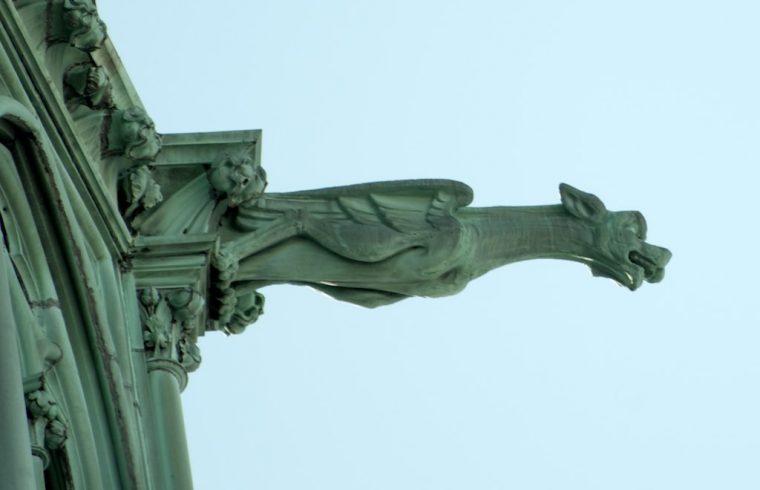A memory of one of my beloved former students was when we had visited the heart of the Archdiocese of Newark – the Cathedral Basilica of the Sacred Heart about 11 years ago. He was, understandably, blown away by the majestic beauty of this place on this his first visit.
Few realize how this Cathedral, only about 10 miles from the world famous St. Patricks in mid-town Manhattan is not only more beautiful but larger then our NY neighbors. As he was admiring Sacred Heart, he said “Father Jim – Question” – I said “OK Matt, what?” And he responded “Gargoyles.” “MATT THAT’S A WORD – THAT’S NOT A QUESTION” to which he clarified as he pointed upwards at the Cathedral and asked “What’s the deal with those things being in here?”
He was confused with a depiction, a representation of something demonic, something evil being part of the stone edifice of that which we call “God’s house” a place where we believe heaven meets earth as the Eucharist is offered and bread and wine become Jesus’ very body and blood. I must confess I hadn’t really noticed the gargoyles before – and had to ask a priest-friend who is an expert and tour guide for the Cathedral. He explained that it’s meant to illustrate evil which is expelled by the things that take place inside a Cathedral.
I hadn’t thought of that incident until recently. This past Friday I was again at our cathedral with students and staff from our campus ministry. This time the young people I was with didn’t notice the sculptures of evil on the stone towers – they saw the words from victims recounting stories of abuse and rape committed by priests and clergy that were hung up inside the walls of the Church. Gathering together for a penitential prayer service in this grave time of scandal for the Church, the signs testified to the evil that was very much alive within the walls of the Church. God’s house has been defiled. We read and heard how the very hands anointed to bring Christ’s body and blood to His people, instead were used to hurt and silence so many for so long.
Then this past evening, our students gathered for our weekly “Newman Night” where we gather for a meal, some fellowship and a discussion on some assorted Catholic topic. In our home, which is God’s house here in the midst of a campus that has over 21,000 students, we spent an hour talking about the filth that has been rotting in the Church for longer than some of us ever thought or knew. (You can see a video of it here: https://www.facebook.com/NewmanCatholicMSU/ ) It had to be done, but it hurt having to discuss these things with kids who make time out of their weeks to come together to talk about and hopefully grow in their faith. Students wrote anonymous questions as they normally do for whatever topic of conversation is up for the night. But instead of clarifying a Church teaching or why Catholics do certain devotions or prayers – the questions were more along the lines of “What do I say to a family member who says they’re not going to be Catholic anymore because of this?”
One sadness in both cases (among a list of things that saddens me) is that when I think back to that earlier incident is that the kids of today won’t ask “What’s the deal with those things being in here” as they reflect on the evil in the midst of the Church. Some will argue that this is always the case. That every one of us is a sinner. That every one of us is in need of God’s mercy, forgiveness and grace. And all of that is very true.
But what is very different is that the innocence is gone.
The gargoyles have become real.
In our hour long discussion tonight though, one reflection that our Campus Minister made was that a personal response he’s had in this summer of scandal. He said that it’s caused him to double down on pursuing holiness himself – recognizing areas in his life where he could be doing better. He mentioned that seeing just how much pain and devastation individuals sins have brought not just to themselves, to the victims, but the entire Church helped crystalize the importance for us to take sin, take evil seriously. That saying “we are all called to be saints” isn’t just a nice saying we put on the walls of religious education classrooms – but something that we hopefully see with an urgency like we’ve never seen before.
I have to admit that was an inkling of hope I’ve longed to hear. For while these kids – or any of us – will never get our innocence back; maybe, just maybe, we can expel all that is vile, all that is evil, all this defiles the Church… Maybe, if we all do get serious about pursuing holiness, we can exorcize the gargoyles for real.











